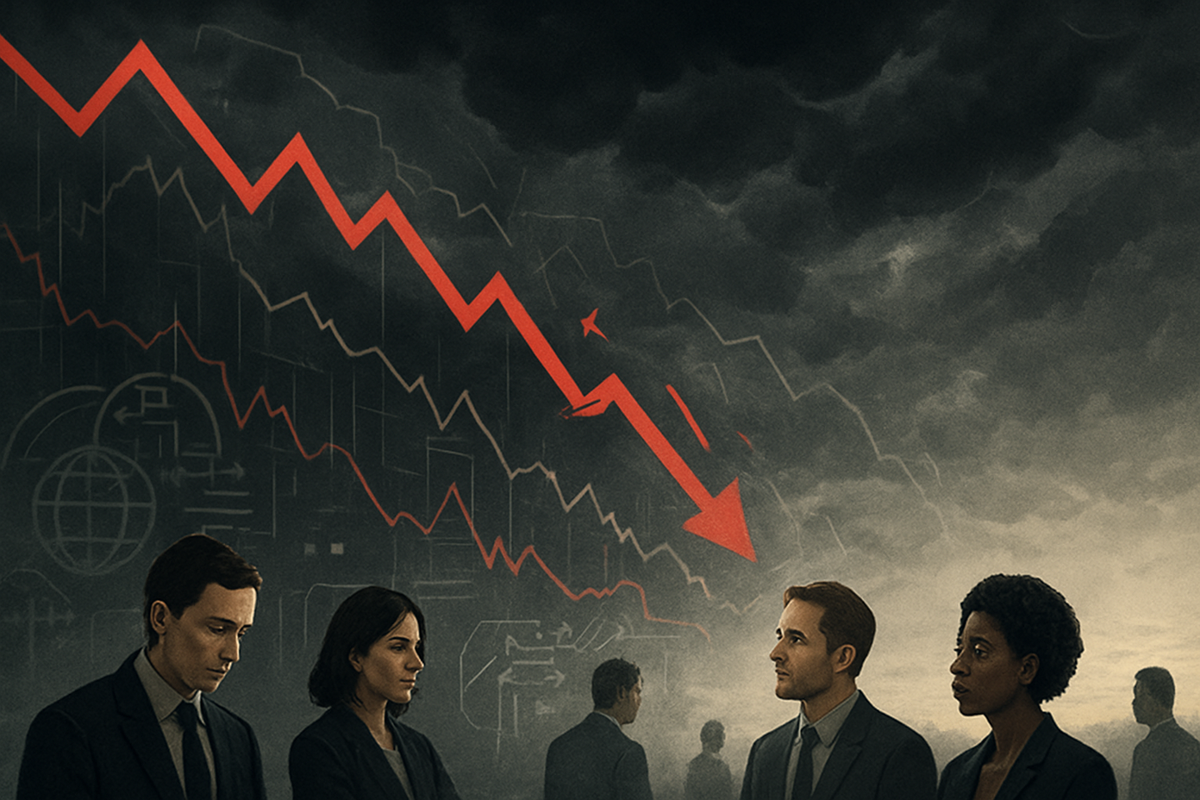Navigating the Tempest: Market Consolidation Amidst Post-Slide Uncertainty

The financial markets, still reeling from a tumultuous period marked by significant downturns, are now grappling with an uneasy attempt at consolidation. As of November 5, 2025, investors are witnessing a landscape fundamentally altered by a series of sharp slides, most notably the tariff-induced crash of April 2025 and a recent tech-led selloff. This period of recalibration presents a complex tableau of challenges and nascent opportunities, forcing a critical re-evaluation of investment strategies and market fundamentals.
The immediate implications are clear: sustained volatility is expected to be the norm, with a palpable shift in investor sentiment away from speculative growth towards a more discerning focus on quality, value, and robust cash flow. While the market endeavors to find its footing, the underlying currents of persistent inflation, interest rate uncertainty, and evolving trade policies continue to exert considerable pressure, making the path to stable recovery a cautious and deliberate one.
A Tumultuous Ride: Tariffs, Tech, and Trillions Lost
The market's recent attempts at consolidation follow a period of intense volatility, most acutely felt in April and November of 2025. The spring of 2025 began with markets at or near record highs, buoyed by optimism surrounding AI and robust corporate earnings. However, this bullish sentiment was abruptly shattered on April 2, 2025, when U.S. President Donald Trump announced sweeping new tariff policies, imposing a minimum 10% tariff on nearly all imports and higher "reciprocal tariffs" on key trading partners like China (34%), the EU (20%), and Japan (24%).
The reaction was immediate and severe. On April 3, the Nasdaq Composite (INDEXNASDAQ: .IXIC) suffered its worst sell-off since the COVID-19 pandemic, plummeting 1,600 points, while the S&P 500 (INDEXSP: .INX) dropped 4.84% and the Dow Jones Industrial Average (NYSEARCA: DIA) fell 1,679 points (3.98%). The panic intensified on April 4, as China retaliated with its own 34% tariff on U.S. imports. This led to the DJIA falling an additional 2,231 points (5.5%), and the S&P 500 losing another 5.97%, marking its worst-ever two-day period. In just 48 hours, over $6.6 trillion was wiped from global market values, and the Nasdaq officially entered bear market territory. The "fear gauge," the Chicago Board Options Exchange's VIX benchmark, spiked to 45.31 points, its highest close since the 2020 crash, reflecting widespread investor anxiety. A brief reprieve came on April 9, when the Trump administration paused tariff increases, leading to a market rally and a recovery for the S&P 500 by mid-May.
However, the market's fragility was once again exposed in early November 2025. After a strong run throughout 2024 and early 2025, largely led by AI-related tech stocks, concerns about stretched valuations began to mount. The Nasdaq Composite had rallied for seven consecutive months, gaining over 50% from its April low, but this narrow market leadership created a vulnerability. Warnings of an "AI bubble" intensified, and an ongoing U.S. government shutdown, then in its fifth week, further eroded confidence.
The selloff truly took hold in early November, with the Nasdaq Composite leading declines, sliding 2% on November 4 and experiencing its largest one-day percentage drop in nearly a month. The S&P 500 dropped 1.2%, and the Dow Jones Industrial Average slid 0.5%. Major tech players, including the "Magnificent Seven" (such as Nvidia (NASDAQ: NVDA), Microsoft (NASDAQ: MSFT), Amazon (NASDAQ: AMZN), Apple (NASDAQ: AAPL), Alphabet (NASDAQ: GOOGL), Meta (NASDAQ: META), and Tesla (NASDAQ: TSLA)), faced steep losses. Notably, Nvidia, Microsoft, and Palantir (NYSE: PLTR) pulled back, with Palantir sinking nearly 8% despite raising revenue guidance, as investors questioned its lofty multiples. Uber (NYSE: UBER) slipped 6%, and Norwegian Cruise Line (NYSE: NCLH) plunged almost 15% after trimming guidance. More than $500 billion was wiped from the value of leading AI chipmakers, signaling a "sober assessment" replacing earlier AI optimism. International markets, including Japan and South Korea, mirrored Wall Street's declines, underscoring the global nature of this tech-led retreat.
The Shifting Sands: Who Wins and Who Loses in a Consolidating Market
In this environment of market consolidation following significant slides, a clear divergence emerges between companies poised for resilience and those facing considerable headwinds. The market's recent movements, particularly the April 2025 tariffs and the November 2025 tech selloff, have reshaped the criteria for success, emphasizing financial prudence and strategic adaptability.
Companies poised to win are generally those characterized by robust financial health, consistent free cash flow (FCF), and a value-oriented approach. Consumer Staples companies, such as PepsiCo (NASDAQ: PEP), which provide everyday necessities, tend to exhibit stable demand and reliable cash flows, making them defensive plays. Similarly, Pharmaceuticals and Healthcare firms, like Pfizer (NYSE: PFE), benefit from inelastic demand for their products and services. Companies with strong balance sheets and the ability to generate substantial cash, even in challenging environments, are better positioned to self-finance growth, reduce debt, and potentially acquire distressed competitors. Furthermore, sectors with limited exposure to tariffs, such as Software and Cloud Services, or domestically focused service industries, are more insulated from global trade disruptions. Mid- and small-cap stocks, which had lagged in previous years, are also seen as potential outperformers, especially with expectations of future Federal Reserve rate cuts.
Conversely, companies likely to lose are those with stretched valuations, high exposure to tariffs, and undiversified global supply chains. The November 2025 tech selloff specifically targeted firms with "lofty AI valuations," where future growth prospects were not immediately justified by current earnings or clear monetization strategies. While underlying technology might be strong, companies like Palantir (NYSE: PLTR), and even some major semiconductor manufacturers, faced significant declines as investors re-evaluated their high price-to-earnings (P/E) ratios. The "Magnificent Seven" tech stocks, despite their overall strength, also felt the impact of this re-assessment.
The April 2025 tariffs created significant vulnerabilities for industries with complex, multinational supply chains. Automakers and Auto Parts Suppliers, including General Motors (NYSE: GM) and Ford (NYSE: F), are heavily reliant on imported materials like steel and aluminum, making them susceptible to increased production costs. Consumer Electronics Manufacturers, along with Retail and Apparel Companies such such as Nike (NYSE: NKE), Adidas (ETR: ADS), Target (NYSE: TGT), and Walmart (NYSE: WMT), which depend heavily on imported goods, face reduced profit margins or the necessity to pass on increased costs to consumers, potentially dampening demand. In essence, the market is favoring resilience and tangible value over speculative growth and global trade dependencies, forcing a re-evaluation of portfolios across the board.
A New Economic Paradigm: Broader Implications and Historical Echoes
The market's current consolidation is not an isolated event but rather a significant turning point, embedding itself within broader industry trends and sending ripple effects across the global economy. This period signifies a shift in investor calculus, moving beyond mere speculation to a more grounded assessment of intrinsic value and operational resilience.
At its core, this consolidation is driven by several overarching industry trends. Technological advancement, particularly in Artificial Intelligence (AI), continues to be a paramount driver, with companies strategically acquiring AI businesses or integrating AI capabilities to maintain a competitive edge. This has led to significant deals in AI, cloud services, and cybersecurity, even amidst the recent tech selloff, as firms recognize AI as a critical component for future growth. Alongside this, digital transformation across sectors and the evolving landscape of healthcare (especially healthtech and biotech) are also spurring M&A activity. Crucially, supply chain resilience has become a strategic imperative. The volatility stemming from geopolitical tensions and the April 2025 tariffs are forcing companies to consolidate and acquire to strengthen critical supply chains, reduce dependencies, and build more robust, localized operations.
The ripple effects of this consolidation are profound. As larger entities merge and expand, smaller, less capitalized competitors face intensified pressure, potentially leading to further acquisitions or forcing them into niche markets. Supply chain dynamics are also being fundamentally altered; merged entities may renegotiate contracts or vertically integrate, impacting existing partners and reshaping the entire ecosystem. While consolidation can foster greater efficiency and R&D investment for the merged entity, it also raises concerns about stifled innovation if dominant players face reduced competition. Furthermore, the market has seen workforce rationalization, particularly in the tech sector, as companies seek efficiency after periods of rapid growth, impacting employment.
From a regulatory and policy standpoint, the implications are substantial. The April 2025 tariffs, though partially paused, introduced significant market instability, fueled inflation, and necessitated rapid adaptations in inventory management and supply chain restructuring for businesses. Central banks, especially the Federal Reserve, are navigating a delicate balance. While stabilizing interest rates and anticipated rate cuts in 2025 have encouraged some deal-making, persistent inflationary pressures or shifts in labor market trends could delay these cuts, leading to renewed volatility. The Fed's conclusion of its balance sheet reduction program by December 2025 also signals potential challenging economic conditions ahead. Regulators are also expected to intensify antitrust scrutiny of "megadeals" to prevent monopolies and ensure fair competition, a critical check on the pace and scope of consolidation.
Historically, the current climate draws parallels to the late 1990s dot-com bubble, particularly concerning the high valuations seen in certain technology and AI-related stocks. While today's tech giants often boast stronger fundamentals and lower forward P/E ratios than their dot-com predecessors, the recent tech selloff serves as a stark reminder of how quickly speculative bubbles can deflate. The April 2025 tariff-induced crash is also likened to the 2020 COVID-19 stock market crash in terms of its immediate, widespread impact. Moreover, the bond market volatility observed in early 2025, where waning investor confidence in U.S. fiscal policy led to widespread selling, has been termed an example of "bond vigilantism," echoing events like the UK's "Liz Truss moment" in 2022. These historical precedents underscore the fragility of market sentiment and the interconnectedness of fiscal policy, trade, and investor confidence.
The Road Ahead: Navigating Future Possibilities and Strategic Imperatives
As the market attempts to consolidate after a period of intense turbulence, the path forward presents a complex interplay of short-term volatility and long-term strategic reorientation. Beyond November 2025, investors and corporations alike must prepare for a dynamic landscape shaped by technological innovation, evolving corporate strategies, and shifting economic fundamentals.
In the short-term (late 2025 - early 2026), continued market sensitivity and potential pullbacks are likely. While some analysts view the current consolidation as a "healthy pause," the recent tech-fueled slides indicate a market prone to corrections. Technical indicators, such as the megaphone pattern in the S&P 500 (INDEXSP: .INX), suggest a risk of a significant correction, potentially 10% to 20% or more, exacerbated by high valuations and debt constraints. However, for long-term investors with cash on the sidelines, these pullbacks could present attractive buying opportunities. The long-term outlook (beyond 2026), however, remains robust. Artificial Intelligence (AI) is expected to be a sustained growth driver, revolutionizing industries and attracting significant investment. Earnings growth is projected to broaden beyond just technology, encompassing healthcare, industrials, and consumer discretionary, supported by a global cyclical acceleration and anticipated interest rate easing.
For companies, strategic pivots and adaptations are paramount. The pursuit of cost savings and operational efficiency through economies of scale will remain a core driver of consolidation, allowing firms to enhance market power and competitiveness. Technological advancement and innovation, particularly in areas like generative AI, automation, and cloud computing, are crucial for maintaining competitive offerings and cost positions. Companies must foster a culture of innovation, leverage data analytics for informed decision-making, and embrace comprehensive digital transformation. Furthermore, risk mitigation and resilience will be key; consolidation can serve as a strategy to diversify product offerings and reduce dependence on single revenue streams, making entities more robust against market fluctuations. Small and medium enterprises, in particular, may need to seek strategic alliances or focus on niche markets to compete effectively.
Emerging markets (EMs) present both significant opportunities and distinct challenges. Characterized by rapid growth and industrialization, EMs offer new avenues for businesses seeking growth potential, particularly in e-commerce, renewable energy, and infrastructure. A weaker U.S. dollar, anticipated due to policy objectives and valuation concerns, could further benefit EMs by easing external debt and boosting commodity prices. However, EMs also face increased competition from local startups, cultural and regulatory complexities, and potential funding constraints. Future M&A activity in EMs is expected to emphasize cross-border transactions, driven by the desire for geographic diversification and access to new technologies.
Several potential scenarios and outcomes could unfold. An M&A rebound scenario is projected for 2025 and beyond, fueled by anticipated lower interest rates and the imperative for strategic growth and scale, potentially leading to further industry concentration in sectors like healthcare, technology, and financial services. Sector-specific divergences are also likely: AI, cloud computing, and cybersecurity will remain powerhouses; healthcare is expected to recover; financials could benefit from post-election momentum; and energy may see sustained high prices. While a market correction scenario remains a risk, such downturns can create opportunities for long-term investors. The shape of economic recovery—whether V-shaped, U-shaped, W-shaped, or K-shaped (where some industries recover strongly while others struggle)—will ultimately define the post-consolidation landscape, demanding agility and foresight from all market participants.
The Path Forward: A Call for Vigilance and Strategic Adaptation
The market's recent journey through slides and subsequent consolidation underscores a critical juncture in the financial landscape. As of late 2025, the overarching narrative is one of cautious optimism, tempered by persistent challenges, and a clear shift towards fundamental strength and resilience. The tech-led selloff in November, following the tariff-induced crash in April, served as a stark reminder that even the most bullish narratives can be quickly recalibrated, leading to a flight to quality and a re-evaluation of stretched valuations.
Looking ahead, the market is poised for continued navigation through these mixed signals. While AI investments are expected to remain a significant long-term driver, the immediate future may see continued volatility, presenting both risks and opportunities for strategic investors. The Federal Reserve's dovish pivot, with anticipated rate cuts into 2026, is expected to provide some liquidity and support for risk assets, potentially offsetting some of the negative impacts of slowing growth and inflationary pressures. This monetary policy tailwind, coupled with generally robust corporate earnings, sets the stage for a potential broadening of market leadership beyond the mega-cap tech giants.
The lasting impact of this consolidation could be a fundamental recalibration of market dynamics. The "buy the dip" phenomenon, while still present, is now accompanied by a more discerning eye for value and sustainable growth. The structural shifts, including geopolitical fragmentation and the erosion of long-term macro anchors like stable inflation expectations, suggest that elevated uncertainty will be a persistent feature of the investment landscape. Companies that can demonstrate agility, operational efficiency, and a clear path to profitability, rather than relying solely on speculative growth, will be best positioned for sustained success.
For investors, vigilance and a diversified approach will be paramount in the coming months. It is crucial to monitor inflation data and Federal Reserve commentary for clarity on future rate policies, as unexpectedly persistent inflation could lead to tighter monetary conditions. Corporate earnings reports and forward guidance, especially from sectors beyond mega-cap tech, will offer insights into broader economic health. Labor market data, particularly unemployment rates and job creation figures, will be key indicators for the Fed's easing stance. Furthermore, geopolitical developments and trade policy shifts could introduce significant volatility. Lastly, watching valuation spreads across different market capitalizations and styles, and observing the breadth of AI sector performance, will help identify emerging opportunities in potentially undervalued segments like small-cap and value stocks. In this evolving environment, a balanced and adaptive strategy will be essential for navigating the complexities and capitalizing on the opportunities that emerge.
This content is intended for informational purposes only and is not financial advice



